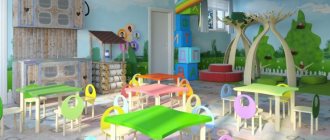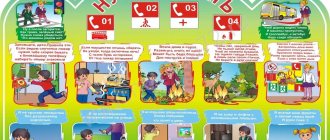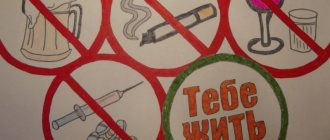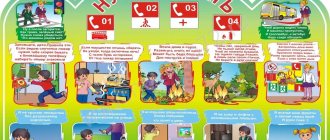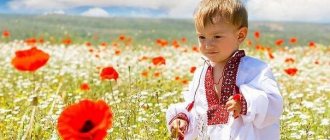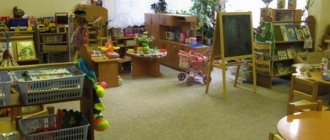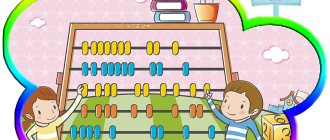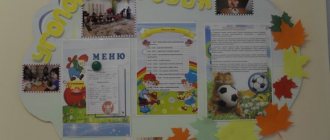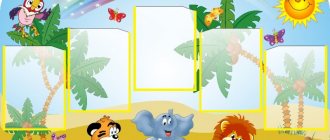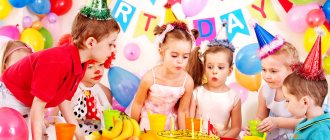Contents of experimentation cornersmaterial on the topic
Contents of experimental activity corners.
Objectives of the corner: development of primary natural science concepts, observation, curiosity, activity, mental operations (analysis, comparison, generalization, classification, observation); formation of skills to comprehensively examine a subject.
In the corner of experimental activities (mini-laboratory, science center) the following should be allocated: 1) a place for a permanent exhibition, where a museum and various collections are located. Exhibits, rare objects (shells, stones, crystals, feathers, etc.) 2) a place for instruments A place for storing materials (natural, “waste”) 3) a place for conducting experiments 4) a place for unstructured materials (sand, water, sawdust , shavings, polystyrene foam, etc.)
Junior preschool age
| Didactic component | Equipment component | Stimulating component |
| - books of an educational nature for younger children; - thematic albums; - collections: seeds of various plants, pine cones, pebbles, collections “Gifts:” (winter, spring, autumn), “Fabrics”. | - Sand, clay; - a set of rubber and plastic toys for playing in the water; - materials for playing with soap foam, non-painting dyes (gouache, watercolor paints). The simplest instruments and devices: - Magnifying glasses, water vessels, a “box of sensations” (a wonderful bag), a mirror for playing with a “sunny bunny”, containers from “kinder surprises” with holes, substances and herbs with different odors are placed inside. - “waste material”: ropes, laces, braid, wooden spools, clothespins, corks - seeds of beans, beans, peas | - rules for working with materials accessible to young children are posted in a prominent place. - characters with certain traits (“why”) on whose behalf a problematic situation is modeled. |
Middle preschool age
| Didactic component | Equipment component | Stimulating component |
| - books of an educational nature for middle age; - thematic albums; - collections: seeds of various plants, pine cones, pebbles, collections “Gifts:” (winter, spring, autumn), “Fabrics”. “Paper”, “Buttons” - Mini-museum (various themes, for example “stones”, miracles of glass”, etc.) | - Sand, clay; - a set of rubber and plastic toys for playing in the water; - materials for playing with soap foam, dyes - non-food (gouache, watercolor paints). - seeds of beans, beans, peas - some food products (sugar, salt, starch, flour) The simplest instruments and devices: - Magnifying glasses, water vessels, “box of sensations” (wonderful bag), a mirror for playing with a “sunny bunny”, containers from “kinder surprises” with holes, substances and herbs with different smells are placed inside. - “waste material”: ropes, laces, braid, spools wooden, clothespins, corks | - rules for working with materials accessible to middle-aged children are posted in a prominent place. - characters with certain traits (“why”) on behalf of whom a problem situation is modeled. - card diagrams for conducting experiments (filled out by the teacher): the date is set, the experiment is sketched. |
Senior preschool age
| Didactic component | Equipment component | Stimulating component |
| - diagrams, tables, models with algorithms for performing experiments; - a series of paintings depicting natural communities; - books of an educational nature, atlases; - thematic albums; - collections - a mini-museum (the topics are different, for example, “There are different watches:”, “Products” made of stone." | - materials are divided into sections: “Sand, clay, water”, “Sound”, “Magnets”, “Paper”, “Light”, “Glass”, “Rubber”; - natural materials: stones, shells, saw cuts and tree leaves , moss, seeds, soil of various types, etc.; - recycled material: wire, pieces of leather, fur, fabric, plastic, wood, cork, etc.; - technical materials: nuts, paper clips, bolts, nails, screws, screws, construction parts, etc.; - different types of paper: plain, cardboard, sandpaper, copy paper, etc.; - dyes: food and non-food (gouache, watercolors, etc.); - medical materials: pipettes with rounded ends, flasks, wooden sticks, measuring spoons, rubber bulbs, syringes without needles - other materials: mirrors, balloons, butter, flour, salt, sugar, colored and transparent glasses, candles, etc. - sieve, funnels - halves of soap dishes , ice molds, parting assistants: magnifying glass, hourglass, microscopes, magnifying glasses, oilcloth aprons, sleeves, rubber gloves, rags | - mini-stand “What I want to know about tomorrow”; - children’s personal notebooks for recording the results of experiments; - hint cards (permissive - prohibitory signs) “What is possible, what is not” - characters with certain traits (“why”) from whose name the problem situation is modeled. |
To help the teacher:
MEMO "Planning work with children on experimentation"
Junior preschool age
Work with children of this age group is aimed at creating the conditions necessary for sensory development during familiarization with the phenomena and objects of the surrounding world. In the process of developing elementary examination actions in children, teachers are recommended to solve the following tasks: 1) combine the display of an object with the child’s active action to examine it: palpation, hearing, taste, smell (a didactic game like “Wonderful Bag” can be used);2 ) compare objects that are similar in appearance: fur coat - coat, tea - coffee, shoes - sandals (didactic game like “Make no mistake”); 3) teach children to compare facts and conclusions from reasoning (Why is the bus stopping?); 4) actively use experience of practical activities, play experience (Why doesn’t the sand crumble?); The main content of the research carried out by children involves the formation of ideas in them: 1. About materials (sand, clay, paper, fabric, wood).2. About natural phenomena (snowfall, wind, sun, water; games with the wind, with snow; snow as one of the aggregate states of water; heat, sound, weight, attraction).3. About the world of plants (methods of growing plants from seeds, leaves, bulbs; germination of plants - peas, beans, flower seeds).4. About ways to study an object (section “Cooking for dolls”: how to brew tea, how to make a salad, how to cook soup).5. About the “1 minute” standard.6. About the objective world (clothing, shoes, transport, toys, paints, etc.).
In the process of experimentation, children's vocabulary is replenished with words denoting sensory signs of a property, phenomenon or object of nature (color, shape, size: crumples - breaks, high - low - far, soft - hard - warm, etc.).
Middle preschool age Work with children of this age group is aimed at expanding children's ideas about the phenomena and objects of the surrounding world. The main tasks solved by teachers in the process of experimentation are: 1) active use of the experience of children's play and practical activities (Why do puddles freeze at night and thaw during the day? Why does the ball roll?); 2) grouping objects according to functional characteristics (What are shoes, dishes needed for? ?For what purpose is it used?);3) classification of objects and objects by type (teaware, tableware).I. The main content of research conducted by children involves the formation of the following ideas in them: 1. About materials (clay, wood, fabric, paper, metal, glass, rubber, plastic).2. About natural phenomena (seasons, weather phenomena, objects of inanimate nature - sand, water, snow, ice; games with colored pieces of ice).3. About the world of animals (how animals live in winter and summer) and plants (vegetables, fruits), the conditions necessary for their growth and development (light, moisture, heat).4. About the objective world (toys, dishes, shoes, transport, clothing, etc.).5. About geometric standards (circle, rectangle, triangle, prism).6. About a person (my assistants are eyes, nose, ears, mouth, etc.). In the process of experimentation, children's vocabulary is replenished with words denoting the properties of objects and phenomena. In addition, children get acquainted with the origin of words (such as: sugar bowl, soap dish, etc.). At this age, construction games are actively used to determine the characteristics and properties of objects in comparison with geometric standards (circle, rectangle, triangle, etc. .d.).
Senior preschool ageWork with children is aimed at clarifying the entire range of properties and characteristics of objects and objects, the relationship and interdependence of objects and phenomena. The main tasks solved by the teacher in the process of experimentation are: 1) active use of research results in practical (everyday, play) activities (How to quickly build a durable house for dolls?); 2) classification based on comparison: by length (stockings - socks) , shape (scarf - shawl - headscarf), color/pattern (cups: single and multi-colored), material (silk - wool dress), density, texture (game “Who can name the most qualities and properties?”). The main content of the research, conducted by children, involves the formation of the following ideas in them: 1. About materials (fabric, paper, glass, porcelain, plastic, metal, ceramics, foam).2. About natural phenomena (weather phenomena, the water cycle in nature, the movement of the sun, snowfall) and time (day, day - night, month, season, year).3. About the aggregate states of water (water is the basis of life; how hail, snow, ice, frost, fog, dew, rainbow are formed; examining snowflakes with a magnifying glass, etc.).4. About the plant world (surface features of vegetables and fruits, their shape, color, taste, smell; examination and comparison of plant branches - color, shape, location of buds; comparison of flowers and other plants).5. About the objective world (generic and specific characteristics - freight, passenger, sea, railway, etc.) transport.6. About geometric standards (oval, rhombus, trapezoid, prism, cone, ball).
In the process of experimentation, children's vocabulary is enriched with words denoting the properties of objects and phenomena. In addition, children become acquainted with the origin of words, homonyms, the polysemy of words (key), synonyms (beautiful, wonderful, wonderful), antonyms (light - heavy), as well as phraseological units (“horse in apples”).
